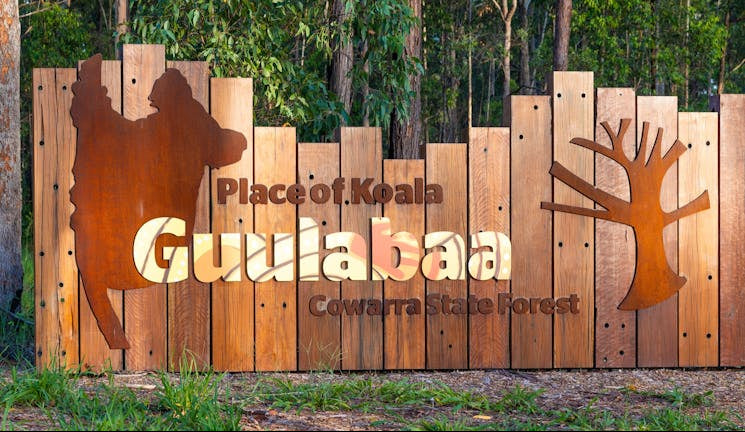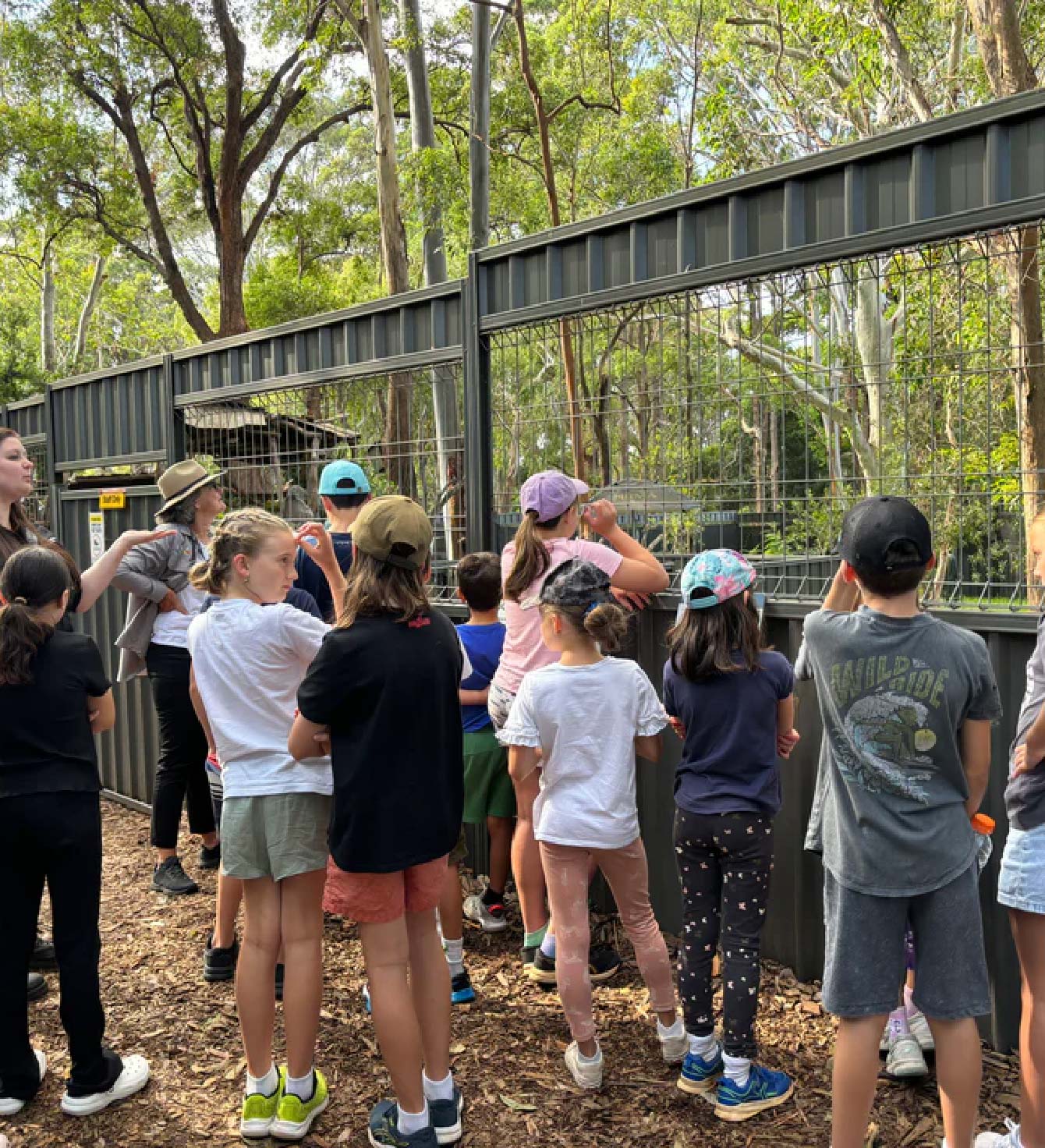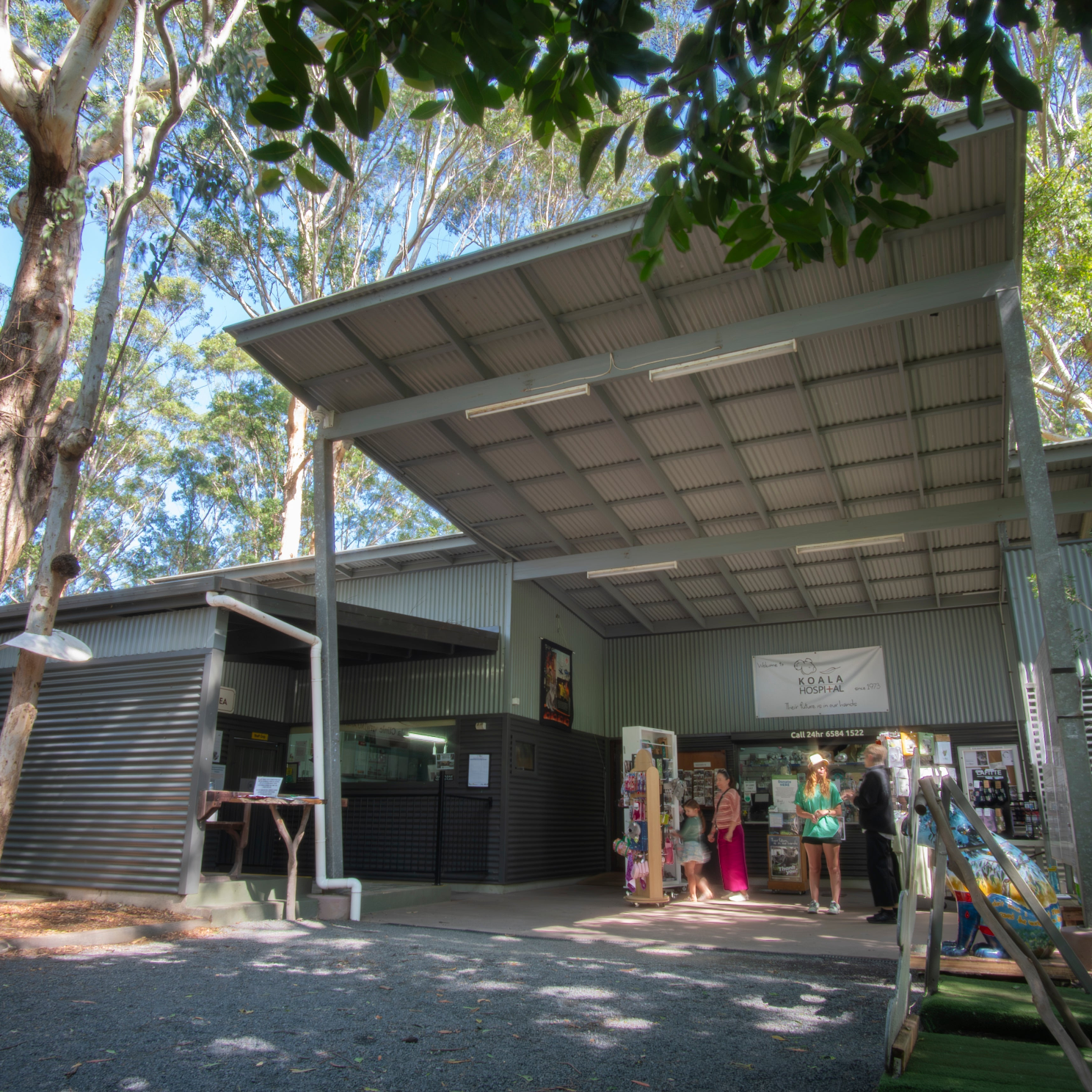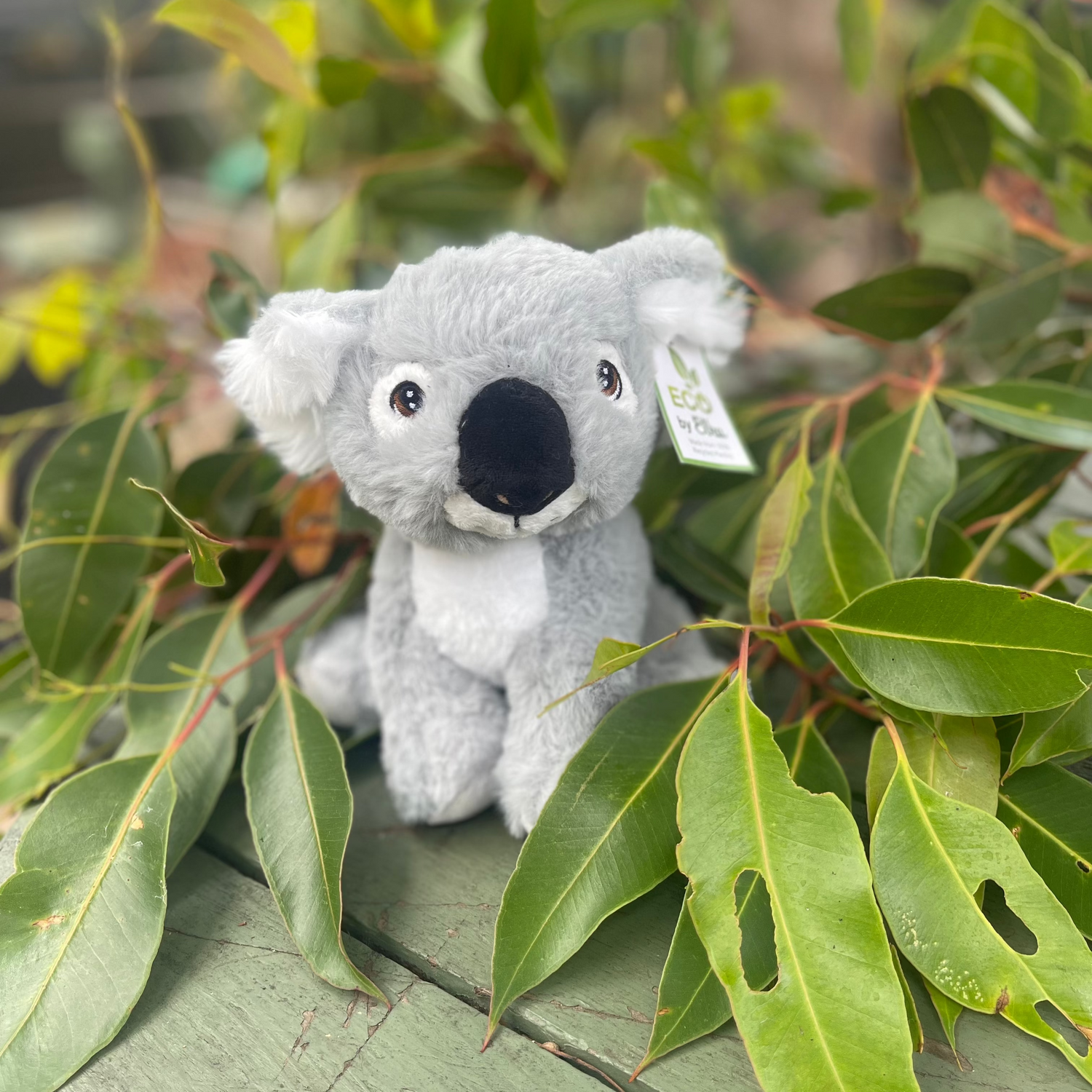Koala Hospital
Koala Hospital Temporary Relocation
The Port Macquarie Koala Hospital's Lord Street site is currently closed to the public as we begin our exciting redevelopment project. We will reopen the at this site in 2026.
But you can still visit the Hospital - in a new location!
Our entire Hospital and all of our resident koalas, is now housed at Guulabaa - Place of Koala.
Visit us and learn about the rescue, rehabilitation and treatment of koalas, along with our breeding program, at our NEW Wild Koala Breeding Visitor Centre at Guulabaa - Place of Koala
Koala Conservation Comes to Life at Guulabaa
Koala Hospital Redevelopment
While our Koala Hospital undergoes redevelopment, we’re thrilled to invite you to visit Guulabaa – our dedicated Koala Conservation Wild Breeding Visitor & Education Centre.
At Guulabaa (which means ‘Place of the Koala’ in Gathang language), you can observe resident koalas such as Nero, Casper, Benny, Phil, Ella, Bobby, Baz, Hunter and Trish.
Enjoy accessible viewing decks, explore interactive exhibits and conservation displays. Watch veterinary care in action at our new koala clinic and learn about our groundbreaking wild koala breeding program.
Don't forget to browse our onsite shop, which offers a variety of unique koala-themed gifts and artisan wares. Plus, enjoy everything the Guulabaa precinct has to offer – from forest walks and the Wildnets Adventure Park, to the iconic Big Koala sculpture and the Bunyah Land Council café.


AN UNFORGETTABLE EXPERIENCE
Welcome to the Koala Conservation Hospital Port Macquarie
We welcome over 100,000 visitors each year to our Koala Hospital, where we provide treatment and care for sick and injured koalas. The Port Macquarie region has one of the largest koala populations in the country, and we were the first dedicated Koala Hospital in Australia!
From 3 May 2025, the Port Macquarie Koala Hospital will temporarily relocate to our Wild Koala Breeding Visitor Centre at Guulabaa - Place of Koala, as we redevelop the Hospital site and work to enhance our facilities for both koalas and the community. While we transform our space, you can still visit your favourite furry friends at our brand-new home, Guulabaa - Place of Koala.
Opening Hours
OUR PORT MACQUARIE KOALA HOSPITAL SITE IS CURRENTLY CLOSED TO THE PUBLIC FOR REDEVELOPMENT - REOPENING 2026.
YOU CAN FIND OUR HOSPITAL OPERATIONS AND RESIDENT KOALAS AT THE WILD KOALA BREEDING VISITOR CENTRE.
Location
Guulabaa – Place of Koala:
Find us on Guulabaa Way, Off Burrawan Forest Drive,
Lake Innes NSW 2446.
Parking, disabled parking, bus parking, and public toilets are available on site.
Rescue
Available 24/7, our Rescue Hotline, team, and koala ambulance ensure a rapid response for koala rescues
Rehabilitate
Providing expert care to treat and compassionately heal injured koalas, preparing them for a new life
Release
Successfully treated koalas are carefully reintroduced to their wild habitats to thrive again, ensuring sustainability
Research
Focused research on diseases, drug therapies and habitats to enhance koala conservation efforts

Meet our koalas
Take a peek at some of the koalas you'll meet at our sites! Every koala has a story to tell....
TREASURES AND TALES
Koalaseum & Gift Shop
What’s a Koalaseum? It’s a museum for koalas of course! It’s a fun interactive space where you can learn about koala life, koala evolution and biology. Listen to koala sounds and touch koala fur!
At our Gift Shop, you can choose from a range of adorable koala toys, giftware made by local artisans and merchandise. With all profits going to Koala Conservation Australia, you can shop guilt-free! We also have a limited range of merch available from our online shop.


Cafe at Roto House
We’re lucky enough to have a fabulous café right next door!
Home @ Roto-open 7 days- is located in 'Roto House', a beautifully preserved late-Victorian building surrounded by 4 hectares of lawns and trees (managed by National Parks). Great coffee, tasty treats, and plenty of space indoors and out. Grab one of Roto’s picnic rugs and relax under an umbrella on the lawn.
Explore Roto House (a tourist attraction in its own right) and take a step back in time. You’ll often find a local art exhibition on display as well. An idyllic place for the whole family, the Cafe is open 7 days (8am to 4.30pm Dec-Feb, and 8.30am-3pm Mar-Nov).
JOIN OUR MISSION
Get Involved
Adopt a Koala
Donate
Volunteering

curious about koalas?
FAQ’s
Are 'Koala Bears' actually bears?
No! Koalas aren't bears, so the term 'koala bear' is incorrect! It's likely popular as koalas can look like small fluffy teddy bears, even though they're not bears at all, they're tree-dwelling marsupials!
At what age do joeys emerge from their mother’s pouch?
Most joeys emerge from the pouch at around 5-6 months, they usually weigh anywhere from 450 grams upward (depending on where they come from). These young emergent joeys sit hugging their mothers bellies or clinging to her back. Eventually they become fully back young, until they are too heavy to be carried. The joeys will continue to feed from the mother and are weaned by 12 months of age.
At what age do koalas become sexually active?
The female reaches sexual maturity at the end of her second year or later and physical maturity at the end of her fourth year. Males – about 3 years sexual maturity and reach physical maturity at 4 years. It is not unusual for this to occur at a younger age as well.
Do koalas get drunk on eucalypt leaves?
The eucalypt leaf is very low in viable nutrients and koalas have a slightly lower body temperature and consequently a lower metabolic rate than most other mammals, to reduce the amount of energy expended per day. By sleeping 18-20 hours they conserve energy and their waking hours are used to feed, move and seek out mates during the breeding season. They do not get drunk on eucalypt leaves.
Do koalas only eat gum leaves?
Koalas eat a number of species of eucalypt plus the flowers, buds, stems and bark. Koalas will also eat Allocasuarinas, Corymbias and Melaleucas so their diet is quite varied.
Do only male koalas bellow?
No, females can bellow also.
How can you tell the age of a koala?
Age is mostly determined by tooth wear on the pre-molar and molar teeth (top jaw). Also skull length and crown to rump length in relation to their weight helps to determine whether they are sub-adult (not sexually active) or adult.
How fast can a koala move?
A koala can climb a tree expertly with considerable speed when necessary. On the ground they are also capable of reasonable speed over short distances.
How long do koalas live?
In the Wild – coastal females 15-18 years; males 10-15 years. In harsher koala habitats, their life span can be less. In captivity both can live 15+ years. We hold the World Record for the Oldest Living koala - a female called “Birthday Girl” who died in 2011 at the age of 25 years.
How long do koalas sleep in a day?
Koalas sleep approximately 18 hours out of 24. This is an evolutionary strategy to conserve their energy as the eucalypt leaf is so low in nutrients/energy value.
How many leaves do koalas eat each day?
An adult koala can eat up to a kilo of leaf over a 24 hour period. They often browse and eat for an hour or so, then sleep then feed again hours later.
How many types of eucalypt leaves do koalas eat?
There are approximately 900 species of eucalypt in Australia – in each region koalas are known to feed on anywhere up to 100 different species. Koalas normally have around 10 species that are their main preferred food source. They eat new and mature leaves, buds, flowers and at times bark but the bulk of their diet consists of leaves.
How many poos does a koala do a day?
An adult koala can poo up to 200 pellets in 24 hours.
What natural predators do koalas have?
Domestic dogs are the main predator of koalas. Powerful Owls, Lace Monitors, and Wedge tail Eagles. The number one predator of koalas is the human species.
When do joeys become independent of their mother?
When the joey is about one year old it is no longer dependent on its mother and is fully able to fend for itself. Joeys are able to disperse from the maternal home range from 12 months on.
When they are released, where do you release them?
Adult koalas live in a home range and stay there for their entire lives unless age illness or a higher ranking animal removes them. Therefore adult koalas must be released back to their point of capture or very close by. It is very similar to humans owning a house and backyard.
What happens to joeys and young koalas?
Once joeys leave their mothers home range they become juveniles (like human teenagers) Juvenile male koalas that leave their maternal home ranges often struggle to find unoccupied habitat and tend to live in very poor country for the first few years until they are big enough to challenge bigger, older males. Juvenile females can also struggle to find unoccupied habitat but are usually accepted much more into new koala populations. These young koalas usually disperse well away into other new locations eventually finding new populations and new home ranges. This behavior encourages good genetic diversity.
How big is a koalas home range?
The size of a koalas home range is dictated by the age, sex, health and quality of the habitat. Koalas also belong to a social hierarchy in their population. For example coastal koalas in NSW are found in areas of good soil, high rainfall and in undisturbed habitat and have a high level of the quality food trees. Higher ranking adult male koalas’ home ranges can be up to 100 hectares for one animal, with higher ranking females’ home ranges being slightly smaller. Very old and unwell koalas tend to get pushed out of their home ranges and are often located in poorer harsher areas. Radio tracking of koalas over a 12 month period has found that the majority of koalas tend to partition their home ranges into summer and winter living in either end depending on the season. This makes sense – living in the cool gullies in summer and on the warmer ridges in winter. Many a home owner has said “our resident koala has been gone for months and he has just come back” – this is why. Mountain koalas found on the Great Dividing range are likely to have slightly larger home ranges and koalas on the western plains in harsher conditions often can have even bigger home ranges as their trees are more scattered.
What do the koalas eat in the winter?
The koalas diet is the same in both summer and winter as eucalypts are not deciduous. In spring and early summer, eucalypts have a big flush of growth with the young tips of the leaves being highly prized by koalas. Snow can fall in the mountain areas of NSW and Victoria with koalas usually moving down the slopes during winter getting well below the snow line.
Is caring for koalas expensive?
Treating wild koalas that come into care can be very expensive. Costs include veterinary care, surgery, radiography (x rays) diagnostic imaging, pathology, drugs and daily care. The Koala Hospital has a number of paid staff who run the hospital along with paid leaf collectors who harvest fresh eucalypt leaf daily. The remainder of the large number of jobs required to run a successful hospital are done by the 150 volunteers. The hospital could not survive without their wonderful work. The vast majority of the hospitals funding comes from the generosity of the public. The remainder comes from adopt a wild koala program and from sale of koala related merchandise in our shop.
What happens when a sick koala is rescued?
The koala is admitted into the hospital and is given an initial examination depending on the reason for admission. If the koala has been hit by a car or attacked by a dog it gets immediate treatment. A koala suffering from a disease or an unknown issue is usually left to “settle” for the first 24 hours. The following day the koala goes under a general anaesthetic and is given a full examination which includes blood, pathology and sample collection, ultrasound, and then a treatment plan is put into action. Some koalas arrive in chronic severely ill states and are euthanased on welfare grounds as these koalas tend to be beyond treatment. If the koala does not have chronic advanced disease we will commence treatment. The current treatment plan for the disease chlamydia includes a six week course of medications and in some cases minor surgery. At the end of six weeks the koala is then left alone in the enclosure to recuperate for two weeks. We then re-anaethetise the koala to see if the disease has returned (via a number of tests) and if ok, the koala is ear-tagged, microchipped and then released back to where it was picked up.
How do we identify each koala that comes to the hospital?
Each koala is weighed, sexed, aged and measured on admission. Every koala has its own admission card and patient data. Everything done to the koala is recorded both on their charts and on a data base. The data base holds full patient information and the data goes back to 1973. Once koalas are ready for release they are ear tagged and microchipped. If the koala is captured years later and brought into the hospital, staff can pull up the koalas chart and immediately know its clinical history. Some koalas are warmly called “repeat offenders” as they seem to continually be admitted to the hospital over their lifetime. The majority of these cases occur because these koalas have to continually battle with roads, dogs and all the human obstacles that urban and rural environments produce.
How long have koalas been in Australia?
Fossil evidence has shown that ancestral koalas were part of the mega fauna (giant marsupials) millions of years ago. Modern koalas began to evolve and adapt to the drying of the Australian continent in line with the rise of the eucalypts. Consequently the koalas we see today have been in existence for a very, very long time.
What are the visiting hours?
Is there an entry fee?
Can I touch or hold a koala during my visit?
Is parking available on site?
Are guided tours available?
Are there dining facilities or should I bring my own food?
Can I take photos during my visit?
Do I need to book in advance to visit?
What accessibility facilities do you have?
Are koalas endangered?
Koalas are found from north Queensland down into NSW, ACT, Victoria and South Australia. There are also a number of translocated populations on islands such as Kangaroo, St Bees, Raymond, Snake and Phillip Island. In 2022, the koala was officially listed as an endangered species. Severe droughts that occurred prior to 2019, followed by the 2019/2020 bushfires have had a major impact on the already declining koala populations. Until rigorous scientific survey work of how many koalas are left is completed, how many remain is still really unknown.



- Choosing a selection results in a full page refresh.
- Opens in a new window.